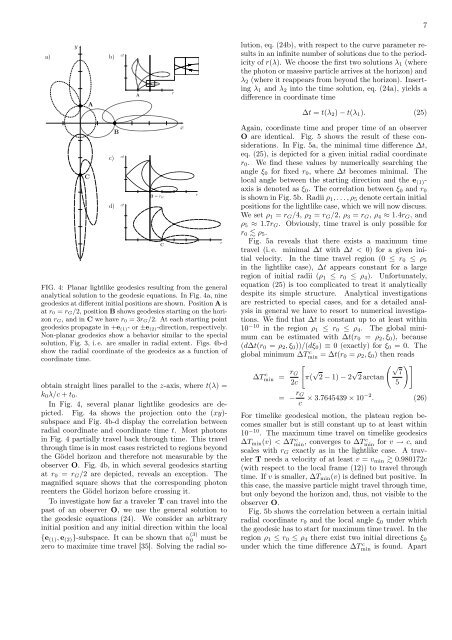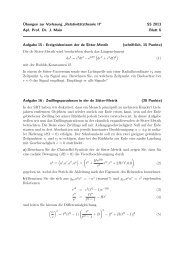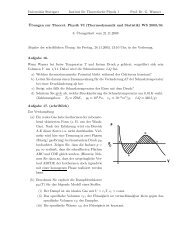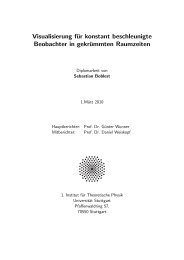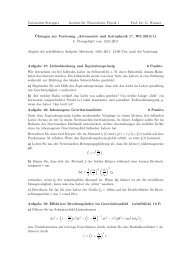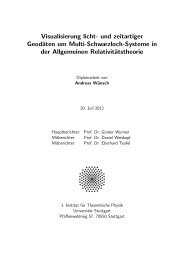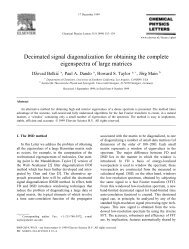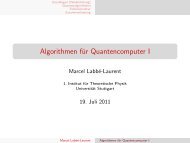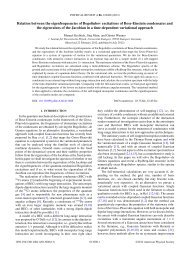The Gödel universe - Institut für Theoretische Physik der Universität ...
The Gödel universe - Institut für Theoretische Physik der Universität ...
The Gödel universe - Institut für Theoretische Physik der Universität ...
Create successful ePaper yourself
Turn your PDF publications into a flip-book with our unique Google optimized e-Paper software.
y<br />
a) b)<br />
C<br />
A<br />
c)<br />
d)<br />
B<br />
ct<br />
ct<br />
ct<br />
A<br />
B = rG<br />
FIG. 4: Planar lightlike geodesics resulting from the general<br />
analytical solution to the geodesic equations. In Fig. 4a, nine<br />
geodesics at different initial positions are shown. Position A is<br />
at r0 = rG/2, position B shows geodesics starting on the horizon<br />
rG, and in C we have r0 = 3rG/2. At each starting point<br />
geodesics propagate in +e(1)- or ±e(2)-direction, respectively.<br />
Non-planar geodesics show a behavior similar to the special<br />
solution, Fig. 3, i. e. are smaller in radial extent. Figs. 4b-d<br />
show the radial coordinate of the geodesics as a function of<br />
coordinate time.<br />
obtain straight lines parallel to the z-axis, where t(λ) =<br />
k0λ/c + t0.<br />
In Fig. 4, several planar lightlike geodesics are depicted.<br />
Fig. 4a shows the projection onto the (xy)subspace<br />
and Fig. 4b-d display the correlation between<br />
radial coordinate and coordinate time t. Most photons<br />
in Fig. 4 partially travel back through time. This travel<br />
through time is in most cases restricted to regions beyond<br />
the <strong>Gödel</strong> horizon and therefore not measurable by the<br />
observer O. Fig. 4b, in which several geodesics starting<br />
at r0 = rG/2 are depicted, reveals an exception. <strong>The</strong><br />
magnified square shows that the corresponding photon<br />
reenters the <strong>Gödel</strong> horizon before crossing it.<br />
To investigate how far a traveler T can travel into the<br />
past of an observer O, we use the general solution to<br />
the geodesic equations (24). We consi<strong>der</strong> an arbitrary<br />
initial position and any initial direction within the local<br />
{e (1),e (2)}-subspace. It can be shown that u (3)<br />
0 must be<br />
zero to maximize time travel [35]. Solving the radial so-<br />
C<br />
r<br />
x<br />
r<br />
r<br />
lution, eq. (24b), with respect to the curve parameter results<br />
in an infinite number of solutions due to the periodicity<br />
of r(λ). We choose the first two solutions λ1 (where<br />
the photon or massive particle arrives at the horizon) and<br />
λ2 (where it reappears from beyond the horizon). Inserting<br />
λ1 and λ2 into the time solution, eq. (24a), yields a<br />
difference in coordinate time<br />
∆t = t(λ2) − t(λ1). (25)<br />
Again, coordinate time and proper time of an observer<br />
O are identical. Fig. 5 shows the result of these consi<strong>der</strong>ations.<br />
In Fig. 5a, the minimal time difference ∆t,<br />
eq. (25), is depicted for a given initial radial coordinate<br />
r0. We find these values by numerically searching the<br />
angle ξ0 for fixed r0, where ∆t becomes minimal. <strong>The</strong><br />
local angle between the starting direction and the e (1)axis<br />
is denoted as ξ0. <strong>The</strong> correlation between ξ0 and r0<br />
is shown in Fig. 5b. Radii ρ1,...,ρ5 denote certain initial<br />
positions for the lightlike case, which we will now discuss.<br />
We set ρ1 = rG/4, ρ2 = rG/2, ρ3 = rG, ρ4 ≈ 1.4rG, and<br />
ρ5 ≈ 1.7rG. Obviously, time travel is only possible for<br />
r0 ρ5.<br />
Fig. 5a reveals that there exists a maximum time<br />
travel (i.e. minimal ∆t with ∆t < 0) for a given initial<br />
velocity. In the time travel region (0 ≤ r0 ≤ ρ5<br />
in the lightlike case), ∆t appears constant for a large<br />
region of initial radii (ρ1 ≤ r0 ≤ ρ4). Unfortunately,<br />
equation (25) is too complicated to treat it analytically<br />
despite its simple structure. Analytical investigations<br />
are restricted to special cases, and for a detailed analysis<br />
in general we have to resort to numerical investigations.<br />
We find that ∆t is constant up to at least within<br />
10 −10 in the region ρ1 ≤ r0 ≤ ρ4. <strong>The</strong> global minimum<br />
can be estimated with ∆t(r0 = ρ2,ξ0), because<br />
(d∆t(r0 = ρ2,ξ0))/(dξ0) ≡ 0 (exactly) for ξ0 = 0. <strong>The</strong><br />
global minimum ∆T c min = ∆t(r0 = ρ2,ξ0) then reads<br />
∆T c min = rG<br />
2c<br />
<br />
π( √ 2 − 1) − 2 √ 2 arctan<br />
√ <br />
7<br />
= − rG<br />
c × 3.7645439 × 10−2 . (26)<br />
For timelike geodesical motion, the plateau region becomes<br />
smaller but is still constant up to at least within<br />
10−10 . <strong>The</strong> maximum time travel on timelike geodesics<br />
∆Tmin(v) < ∆T c min , converges to ∆T c min<br />
5<br />
7<br />
for v → c, and<br />
scales with rG exactly as in the lightlike case. A traveler<br />
T needs a velocity of at least v = vmin 0.980172c<br />
(with respect to the local frame (12)) to travel through<br />
time. If v is smaller, ∆Tmin(v) is defined but positive. In<br />
this case, the massive particle might travel through time,<br />
but only beyond the horizon and, thus, not visible to the<br />
observer O.<br />
Fig. 5b shows the correlation between a certain initial<br />
radial coordinate r0 and the local angle ξ0 un<strong>der</strong> which<br />
the geodesic has to start for maximum time travel. In the<br />
region ρ1 ≤ r0 ≤ ρ4 there exist two initial directions ξ0<br />
un<strong>der</strong> which the time difference ∆T c min is found. Apart


